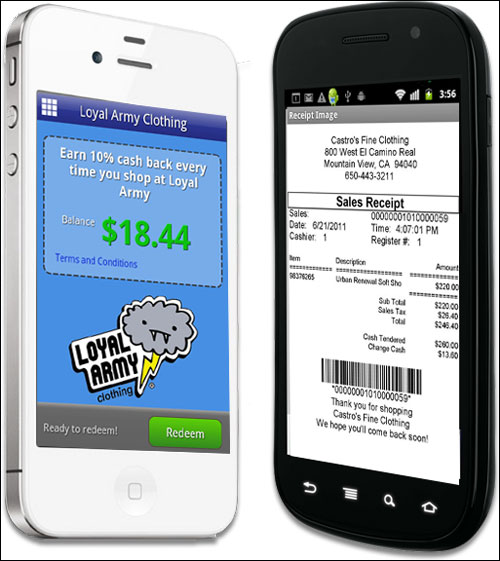California startup Proximiant reports that a dozen San Francisco Bay Area stores are piloting its Near Field Communication (NFC)-based system at the point of sale (POS), enabling shoppers to receive receipts, coupons, loyalty points and store credits on their mobile phones. By late spring 2012, approximately 1,000 stores are expected to participate, according to Fang Cheng, the company’s cofounder and CEO. Since the pilots began in December 2011, stores’ customers have been able to use an NFC-enabled phone—or an NFC-based Proximiant RFID card paired with a non-NFC phone—to download purchase receipts or discount coupons. After installing the Proximiant application on the phone, a customer can tap the NFC phone or card against a transceiver at the point of sale, thereby eliminating the need for paper receipts, coupons or loyalty cards.
Cheng says she conceived the idea in 2010, while traveling for business. She typically traveled between the Bay Area and New York every two weeks, and managed an expense account to pay for the various costs incurred during the trips. However, she says, collecting and storing all of the receipts became so cumbersome that she had a tendency to simply pay for the expenses herself, rather than be bothered with keeping receipts. She began to investigate whether NFC could provide a solution. Not only could an electronic receipt system based on NFC technology save time and trouble for consumers, she explains, but it could also make it easier for merchants to offer customers discounts or loyalty programs. In addition, Cheng notes, there was also the green aspect of using an electronic solution to consider: If she could offer a service for delivering receipts electronically, she could eliminate the need for all of the paper collected and then discarded by shoppers.

Cheng launched the company in March of last year with two other cofounders, and the trio then focused on developing a solution. The partners outsourced the design of the NFC POS device and NFC cards to a third-party contractor, and built the software to manage the read data, as well as a phone app for storing and displaying receipts, coupons and loyalty points.
To utilize the system, a merchant can visit Proximiant’s Web site and request the service, which is currently free for those businesses piloting the technology. Beginning next month, the cost will be $50 for the device with a built-in RFID reader (developed for Proximiant) and 500 consumer NFC cards (made with NXP Semiconductors‘ 13.56 MHz passive RFID NFC chips) in the form factor of a key fob. There will also be a $14.99 monthly fee to manage read data, including the storage of each transaction, with a lower fee for every additional device used. The reading device can be plugged directly into the POS terminal, similarly to a receipt printer, and the store can then download Proximiant’s driver software.
Most consumers do not yet have NFC-enabled phones, Cheng notes. Therefore, stores can provide customers with a Proximiant key fob with a built-in passive NFC RFID inlay, at no cost. Users who have a cell phone can then download the Proximiant app to their phone for free, by visiting the iTunes or Android Market app store. After installing the app, the user inputs the six-digit serial number on the back of the key fob, which then pairs the phone to the fob in Proximiant’s server. A participant need not provide any personal information, since the data is simply linked to the phone rather than to a specific individual using it. When a purchase is made at any participating store, once the transaction is complete, the screen on the POS device lists the items purchased, along with their cost and the total amount due, and invites the customer to tap his or her phone or card against the device in order to receive a receipt. The patron can tap the key fob or NFC-enabled phone within 5 centimeters (2 inches) of the reader—the fob’s RFID inlay can be read through a wallet, so the fob can be kept in a wallet if the consumer so chooses—and the transaction data will then be stored on the phone.
For those with NFC-enabled mobile phones, the data is now stored on their phones, and they can simply scroll through the records to view their receipts. For those using the fob, the information is sent to the phone via an SMS connection. In either case, the phone must be powered on to receive receipts.
The consumer can utilize the Proximiant phone app to later retrieve a receipt by entering the store’s name or the date, or simply scroll through the receipts listed. To return an item for exchange or refund, the shopper can present the receipt on the phone to the merchant, who can employ a bar-code scanner to read the bar code displayed on the electronic receipt. In the event that the store offers incentives, such as a discount for future purchases at that location, this data is also forwarded to the phone at the time of a transaction, and a user can redeem the discount at the point of sale, by presenting his or her phone to the merchant. The system also works for those who lack a mobile phone, Cheng says. For example, a consumer can still receive the NFC key fob, visit Proximiant’s Web site and input the card’s six-digit serial number to view an online record of receipts.
To date, Cheng says, most of the 12 stores have begun using the system only during the past few weeks, having opted to wait until after the Christmas sales season. However, she adds, the first store that piloted the solution reported that 90 percent of customers told about the technology chose to utilize it.
Consumers can not use the Proximiant app or card to pay for a purchase—rather, they would pay for goods as they normally would have done without the Proximiant technology, using cash or a credit or debit card. The solution’s value, Cheng says, is the elimination of receipts, the creation of a record of purchases (including each item within a single transaction) for finance management by the customer, and a channel through which merchants can extend loyalty programs and discounts. According to Cheng, the key fob can be used at the facilities of any participating merchant, enabling shoppers to employ the same system and app at multiple stores.
The stores piloting the Proximiant solution primarily represent fashion merchants, in addition to restaurants and other types of stores, such as bicycle-repair shops (where a record of tune-ups, for example, could be stored). Cheng says Proximiant is currently in discussions with universities across the United States regarding adopting the system for student use at college stores.


